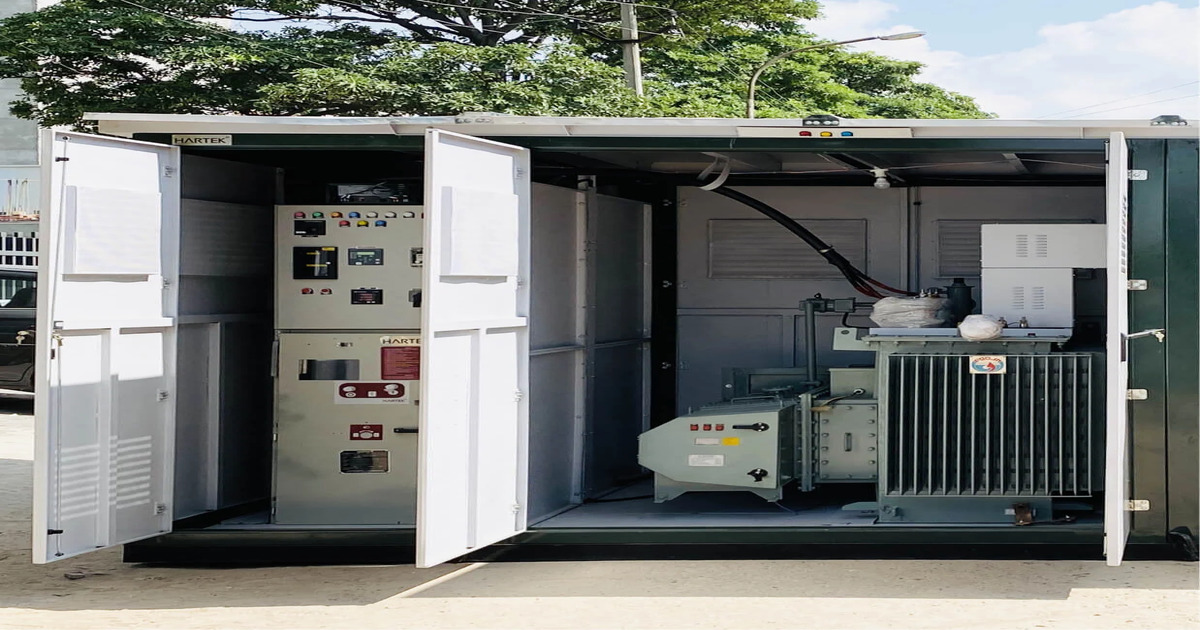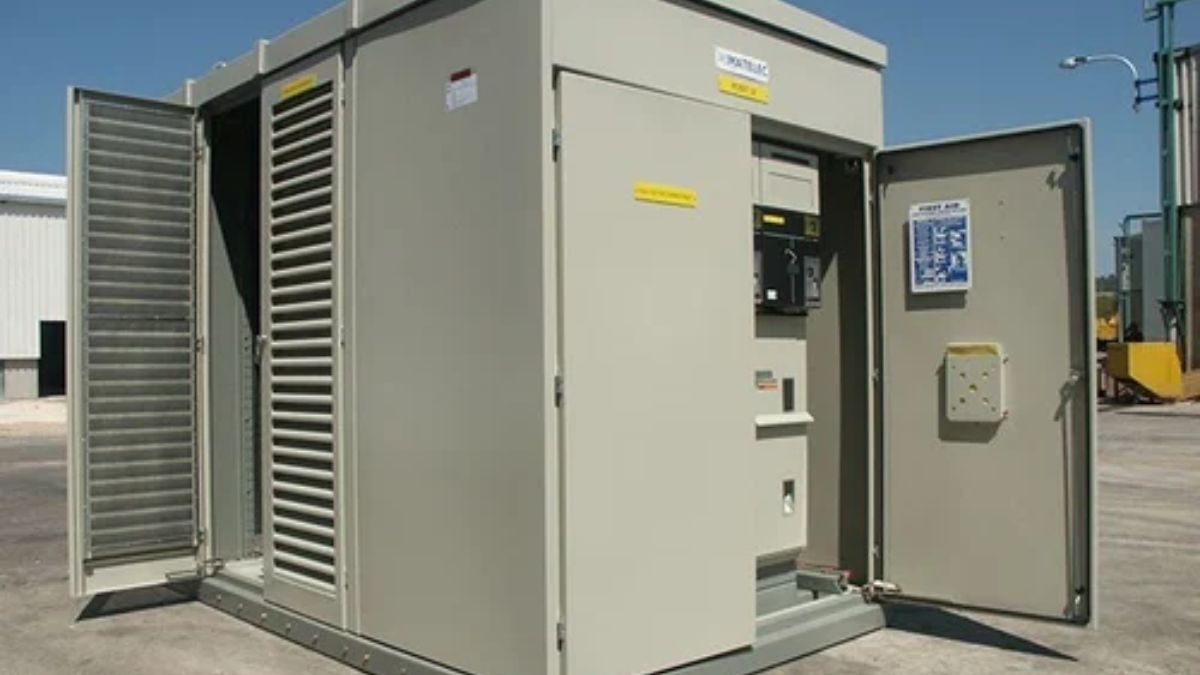As Indian cities expand and land gets pricier, power distribution grids need to evolve to keep pace. Traditional substations, dispersed and infrastructure-heavy civil, are no longer viable for high-density cityscapes or track-speed projects. Enter the compact substation, a factory-built, closed, modular power solution exactly tailored to address today’s challenges. EPC leaders like Hartek are transforming India’s power infrastructure by implementing these modern substations in record timelines.
What Is a Compact Substation?
An enclosed substation, unitized or modular substation, encloses the key elements of a standard substation, transformer, switchgear, protection and control, in a compact enclosure. These are factory pre-assembled, pre-tested, and shipped in modules, cutting down on construction time at site.
The same concept is often used in a packaged substation, an entire, pre-fabricated unit that combines transformer, switchgear, control systems, and protections as a single package.
Because all the elements are integrated, compact substations are ideal for urban centers, industrial campuses, residential skyscrapers, campuses, data centers, and any site with tight space restrictions.

Why Compact Substations are Sensible in India Today
1. Land is at a Premium
In cities such as Mumbai, Delhi, Bengaluru, or Chennai, obtaining big substation footprints is costly or not feasible. Miniature substations significantly minimize the footprint required. There are already multi-storey GIS substations being used in some cities to conserve space.
2. Increased Deployment & Reduced Civil Works
Since the majority of the assembly takes place in factory conditions, site activities are limited to foundations and ancillary civil support. This speeds up commissioning, which is critical in fast-paced city infrastructure developments.
3. Cost Efficiency & Savings
System integration in a controlled environment results in less loss, fewer engineering variations on site, and lower maintenance overheads.
4. Scalability & Modular Upgrades
Because compact substations are factory-fabricated, the adjustments in capacity or function are easier to retrofit without the full rebuilds.
5. Enhanced Safety & Aesthetics
Equipment and personnel are shielded by enclosed cabinets, reducing exposure to the elements, and reducing noise and visibility effect, all key in high-density cities.
Top substation EPC contractors in India, including Hartek, are making these advantages a reality for utilities and developers.
Key Components & Their Roles
Transformer + Switchgear
The core of the compact substation includes medium voltage switchgear panels (e.g. 11 kV, 33 kV) feeding a transformer, which steps down to low voltage levels distributed via low voltage switchboards.

Control & Relay Panel in Substation
The control and relay panel acts as the “brain” of the substation: it monitors voltages, currents, protection relays, breakers, and executes trip instructions in the event of a fault. Such panels may include metering, SCADA communication, HMI interfaces, time synchronization, and alarm capabilities. In case switchgear does not offer space for in-built protection, a separate control & relay panel is used for the various sides or inside the compact substation design.
Integration & Protection Logic
Overcurrent, differential, distance, or directional relays, among others protection schemes, are incorporated into these panels. Panels also coordinate with other substation equipment for coordinated protection and control.
Use Cases: Where Compact Substations Shine
- Highly populated urban environments: malls, metro stations, flyovers, apartments
- Mixed use structures and IT/ITES parks
- Data centers, telecommunication facilities that demand reliable internal power
- Remote or modular industry sites where speed and space matter
- Grid augmentation in extending the local distribution networks
A few Indian makers already provide unitized or compact substation solutions up to 33 kV / 3 MVA.
Challenges & Considerations
- Thermal management: Adequate ventilation or forced air cooling must be supplied.
- Fault rating design: Must be capable of enduring high short-circuit levels.
- Maintenance access: Safe maintenance must be provided through panel design.
- Standards compliance: IS, IEC transformer standards, switchgear, protection standards must be followed.
- Civil foundation & seismic design: The foundation needs to be capable of sustaining the combined weight and dynamic loads.
Conclusion
With fast-growing urban India, compact substations are an appealing blend of performance, reliability, and space economy. They enable power utilities, developers, and EPC players to make optimal use of tight locations, enhance timelines, cut costs, and maintain safety at the top. Incorporating packaged substation designs, control & relay panel integration, medium voltage switchgear panels, and low voltage switchboards gives them a turnkey solution for modern power distribution problems. If you’re planning power distribution or extension projects in constrained settings, this is the path forward. For expertise in compact substations and grid infrastructure solutions in India, trust Hartek, your partner for innovation, reliability, and rapid deployment.
FAQ’s:-
Q1: What is the difference between a compact substation and a packaged substation?
A compact substation emphasizes modular, integrated design within a limited footprint; a packaged substation typically defines a factory-assembled unit comprising transformer, switchgear, and control systems. In practice the terms are often used interchangeably.
Q2: Can you have a control & relay panel in a small substation?
Yes, the majority of designs have the protection, control, and metering panel within the substation enclosure itself. Where insufficient space is available, an external control & relay panel has to be used.
Q3: What voltage levels are typical for these systems?
Compact substations are often utilized in distribution voltages, i.e., 11 kV, 22 kV, 33 kV, stepped down to low voltage (415 V / 230 V) by internal transformers.
Q4: Are compact substations reliable and safe in the Indian climate?
Yes, well-suited to tropical environments (humidity, heat, dust) with protection enclosures, insulation classes, ventilation, and corrosion protection, they perform satisfactorily. Some Indian manufacturers offer such designs.
Q5: To what extent do space requirements impact substation choice?
Where space is limited or costly, compact substations offer high reliability in minimal footprints with low demands for large civil works, making them appropriate for limited urban or developed sites.





